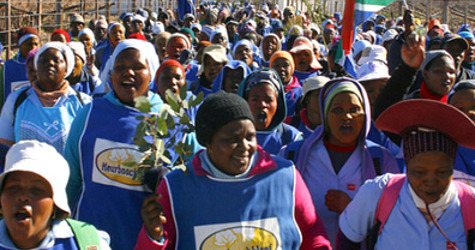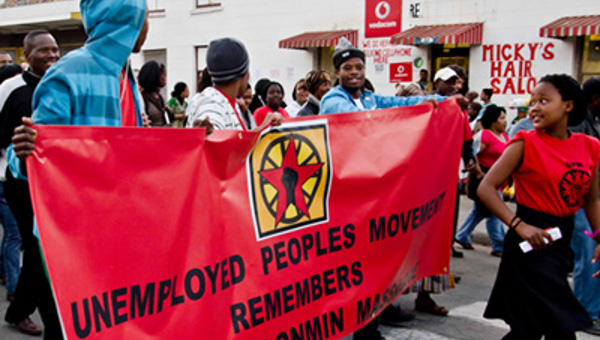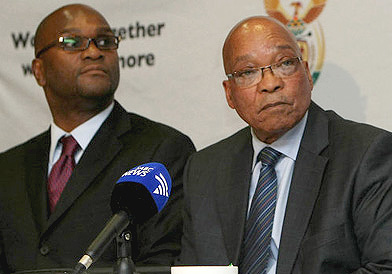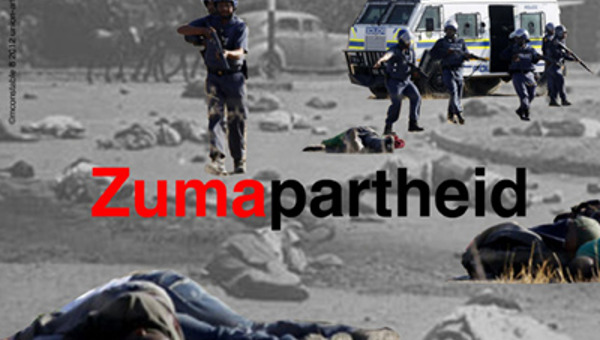The massacre of 34, and almost certainly more, striking mineworkers at Marikana (together with more than 80 injured) on 16 August has sent waves of shock and anger across South Africa, rippling around the world. It could prove a decisive turning-point in our country’s post-apartheid history.
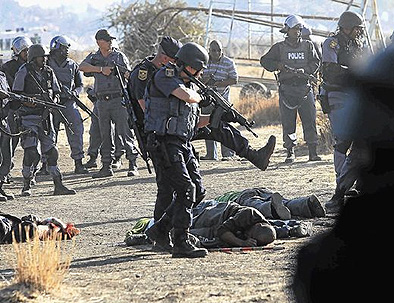
Marikana is a town situated in barren veld, dry brown grass in the winter, with occasional rocky outcrops (kopjes, hillocks). The Lonmin-owned mines – there are three, Karee, West and East Platinum – are situated on the outskirts of the town. Alongside two of them is a settlement of zinc-walled shacks festooned with lines of washing called Enkanini where most of the mineworkers live.
Towering over the shack settlement are the surface buildings of the mine, together with a huge electricity sub-station, with giant power pylons marching across the veld. This is the mineral-energy complex (MEC) which has dominated the South African economy since the 1890s, basing itself on the exploitation of cheap black migrant labour. But now platinum has replaced gold as the core of it. South Africa produces three-quarters of the world’s platinum (used for catalytic converters in cars and for jewellery) and has dropped from first to fifth in production of gold. The underground workers at Marikana are still predominantly from the Eastern Cape, the area most ravaged by the apartheid migrant labour system. One third are contract workers, employed by labour-brokers for the mines, with lower wages and no medical, pension, etc benefits.
Working Conditions
Platinum rockdrillers work underground in temperatures of 40-45 degrees celsius, in cramped, damp, poorly ventilated areas where rocks fall daily. They risk death every time they go down the shafts. At Marikana 3000 mineworkers were and are striking for a wage increase from R4000 to R12,500 a month.
The juxtaposition of the MEC with Enkanini, where outside toilets are shared among 50 people, where there are a few taps that will only trickle water, where raw sewage spreading disease leaks from burst pipes, and children scavenge on rubbish dumps, symptomatises the huge inequalities in South African society today. (More details on living conditions can be found in “Communities in the Platinum Minefields: Policy Gap 6.”)
Inequality has increased since 1994 under the post-apartheid ANC government. CEO’s earn millions of Rands in salaries and bonuses while nearly one third of our people live on R432 a month or less. The top three managers at Lonmin earned R44.6-million in 2011 (Sunday Independent, 26/8/2012). Since 1994 blacks have been brought on board by white capital in a deal with the government – and engage in conspicuous consumption. Cyril Ramaphosa, former general secretary of the National Union of Mineworkers (NUM), who is now a director of Lonmin, recently bought a rare buffalo for R18-million, a fact contemptuously highlighted by Marikana workers when he donated R2-million for their funeral expenses. Unemployment in South Africa, realistically, is 35 to 40 per cent and higher among women and youth – the highest in the world.
The media have highlighted police shooting automatic weapons at striking mineworkers running toward them from the rocky kopje where they were camped, and bodies falling to the ground dead. The police had erected a line of razor wire, with a 5-metre gap in it, through which some mineworkers were attempting to return to Enkanini to escape teargas and water cannon directed at them from behind.
Researchers from the University of Johannesburg (not journalists, to their shame) have revealed that the main killing did not take place there. Most strikers had dispersed in the opposite direction from Enkanini, trying to escape the police. At a kopje situated behind the hill-camp there are remnants of pools of blood. Police markers in yellow paint on this “killing kopje” show where corpses were removed: there are labels with letters at least up to “J.” Shots were fired from helicopters to kill other escaping workers, and some strikers, mineworkers report, were crushed by police Nyalas (armoured vehicles). Within days the whole area was swept clean by police of rubber bullets, bullet casings and tear-gas canisters. Only patches of burned grass are visible, the remains of police fires used to obscure evidence of deaths.
There are still workers missing, unaccounted for in official body counts. The death toll is almost certainly higher than 34.
The cumulative evidence is that this was not panicky police firing at workers they believed were about to attack them armed with machetes and sticks. Why otherwise leave a narrow gap in the razor wire? Why kill workers running away from the police lines? It was premeditated murder by a militarized police force to crush the strike, which must have been ordered from higher up the chain of command. This is further confirmed by autopsies which reveal that most of the workers were shot in the back (Cape Times, 27/8/2012).
Because of the global capitalist crisis, with a slump in demand for new cars, the price of platinum has been falling, squeezing Lonmin’s high profits. Lonmin refused to negotiate with the striking mineworkers, and instead threatened mass dismissals, a favorite weapon of mining bosses. They were losing 2500 ounces of platinum output a day, amounting to more than $3.5-million. It was in Lonmin’s interest to smash the strike. A platinum CEO is quoted as saying that if the R12,500 demand was won “the entire platinum mining sector will be forced to shut down.” (New Age, 20/8/2012)
But the massacre has rebounded in their face. It has reinforced the anger and determination of the Marikana mineworkers to continue striking. “We will die rather than give up our demand,” said one at a protest meeting in Johannesburg on 22 August. Moreover after the massacre workers at Royal BaFokeng Platinum and Anglo American Platinum joined the strike, though now (27/8) at least some appear to have been persuaded to return to work.
The police chief, Riah Phiyega, visited police in Marikana in the days before the massacre. On the day of the massacre a police spokesperson declared “Today is unfortunately D-day” (Business Report, 17/8/2012). After the killings Phiyega said “It was the right thing to do” (The Star, 20/8/2012). The ANC government is implicated in these murders – in defence of white mining capital.
Certainly the massacre has severely damaged the moral authority that the ANC inherited from the liberation struggle. Since 16 August President Jacob Zuma has gone out of his way to distance himself from the killings. He has deplored the tragedy, visited the site six days later – to a cool reception from the mineworkers – declared a week of mourning and established a commission of enquiry. He is hoping to restore the image of the ANC and of himself before he has to face re-election at an ANC conference in Mangaung in December. The commission has five months to report – which he hopes will cover up discussion of the events until after Mangaung. “Wait for the report before making a judgement” will be the watchword of the ANC and its allies in the next months.
Suspicious of the official commission, the mineworkers have called for an independent commission of enquiry, and the dropping of charges against 259 workers who have been arrested. “The same person who gave the order to shoot is the one who appointed the commission,” said a worker (Business Day, 23/8/2012).
Expelled former ANC Youth League president, the populist Julius Malema, has taken advantage of the massacre to visit Marikana, denounce Zuma, and give assistance to the dead mineworkers’ families. Also all leaders of the parliamentary opposition went as a delegation to a meeting in Marikana on 20 August to offer condolences – like flies hovering around a dead body. At the same meeting a procession of twenty or more priests each sought to claim the loudhailer.
The media have claimed that the violence was precipitated by rivalry between the NUM and the Association of Mineworkers and Construction Union (AMCU). This is nonsense. When the Marikana rockdrillers went on strike they wanted to negotiate directly with management, not to have any union represent them. This was made absolutely clear at post-massacre meetings in Marikana, and (including by the AMCU general secretary himself) at the protest meeting on 22 August.
The strike was violent. In the week before the massacre ten people died, six mineworkers, two mine security guards, and two policemen.
NUM and AMCU
Historically the National Union of Mineworkers, with a present membership of some 300,000, born in the struggle against apartheid, has represented mineworkers. It has a proud history of struggle, including the 1987 mineworkers strike, led by Cyril Ramaphosa. But since 1994 it has increasingly colluded with the bosses. At Lonmin it had a two-year wage agreement for 8 to 10 per cent annual increases.
When the rockdrillers struck for more than doubled wages, NUM tried to prevent them. The strikers assert that the NUM was responsible for the death of two of them early in the strike. Two days before the massacre NUM general secretary, Frans Baleni, stated of the strikers, “This is a criminal element” (Business Report, 15/8/2012). Since the massacre Baleni has claimed it was “regrettable” but he has not condemned the police, only “dark forces misleading the workers” (see the video on the NUM website). Baleni earns 77,000 rand a month, more than 10 times what the rockdrillers earn. NUM members in Marikana have torn up and thrown away their T-shirts. At the Johannesburg protest meeting on 22 August an NUM speaker was shouted down by Marikana mineworkers.
The beneficiary is the AMCU, which before the strike had only 7000 members at Karee, a part of the Marikana mine where workers did not strike. (Its membership there was drawn in by a disaffected NUM branch leader after a strike last year.) Now workers from West and East Platinum are joining AMCU.
AMCU was formed after 1999 when its present president, Joseph Mathunjwa was dismissed by a coal mine in Mpumalanga and reinstated because of worker protest, but then faced a disciplinary hearing from NUM for “bringing the union into disrepute.” He was expelled by the NUM (whose general secretary, ironically, was then Gwede Mantashe, now general secretary of the ANC) and formed AMCU.
Today AMCU claims a membership of some 30,000. It represents workers at coal, chrome and platinum mines in Mpumalanga, and coal mines in KwaZulu-Natal. It has members at chrome and platinum mines in Limpopo, and is recruiting at the iron ore and manganese mines around Kathu and Hotazel in the Northern Cape. It has focused on vulnerable contract workers. In February-March this year it gained membership in a six-week strike of 4300 workers (in which four people died) at the huge Impala Platinum in Rustenburg, a 14-shaft mining complex with 30,000 workers. At this stage it is unclear whether it can build solid organization for platinum workers, or merely indulge in populist rhetoric.
AMCU is affiliated to the National Council of Trade Unions (NACTU), rival union federation to the 2 million strong Congress of South African Trade Unions (COSATU), both of them also born in the struggle against apartheid. COSATU, however, is allied with the ANC and partly compromised by its relationship to government.
The platinum strikes and the massacre take place on the eve of COSATU’s 11th congress to be held on 17-19 September. COSATU has long differed with the ANC on economic policy, and in the recent period has been racked by internal differences over this and over whether or not Zuma should have a second term as ANC president and hence, in the 2014 elections, as likely president of the country. COSATU’s president, Sdumo Dlamini, supported by the NUM and the National Health and Allied Workers’ Union (NEHAWU) supports Zuma. General secretary Zwelenzima Vavi, together with the National Union of Metalworkers of South Africa (NUMSA) and the South African Municipal Workers Union (SAMWU), is less keen on Zuma’s re-election. Other unions are divided.
Vavi’s political report to the Congress writes of “total state dysfunction” (concerning the failure of the ANC government to provide textbooks to Limpopo schools) and states there is “growing social distance between the leadership and the rank and file” of the ANC (Mail and Guardian, 10-16/8/2012).
Workers’ Control?
At its June Congress NUMSA passed resolutions on nationalization of industry and declared “that nationalization of the Reserve Bank, mines, land, strategic and monopoly industries without compensation must take place with speed, if we are to avoid sliding into anarchy and violence as a result of the cruel impact of… poverty, unemployment and extreme inequalities in South Africa today.” Under workers’ control and management, this policy could rapidly end inequality and poverty in South Africa.
(Malema and the ANCYL also favour nationalization of the mines, but this is interpreted as a desire to enrich predatory black businessmen who could sell their assets to the state).
NUM is less keen on nationalization. “We are for nationalization, but not a nationalization that creates chaos,” said an NUM spokesperson recently. In a June document NUM criticized “populist demagoguery… calling for nationalization as the solution to… challenges” such as socio-economic conditions and failures by the mining industry to adhere to transformation or mining charter requirements (miningmx, 19/8/2012).
Vavi in his political report also drew attention to “a growing distance between leaders and members” within COSATU unions (Mail and Guardian, 10-16/8/2012) – which applies to the NUM, for example. Recently the NUM general secretary in a private meeting with Vavi warned him to cease his “one-man crusade” or face being unseated at the COSATU Congress.
Now the shock-waves of the massacre will reverberate through the congress. The differences could be magnified, and some observers even predict that COSATU could split either at or after the congress. Both factions of the COSATU leadership, however, are threatened by the erosion of the NUM and the growth of AMCU and other unions attracting disgruntled COSATU members.
A COSATU statement (23/8/2012) speaks of “a co-ordinated political strategy to use intimidation and violence, manipulated by disgruntled former union leaders, in a drive to create breakaway ‘unions’ and divide and weaken the trade union movement.” It says the COSATU Congress will “have to discuss how we can defeat this attempt to divide and weaken the workers, how we can … cut the ground from under the feet of these bogus breakaway ‘unions’ and their political and financial backers.” The threat to workers’ unity is a powerful stick with which to temporarily re-unite the factions in COSATU. This strategy will be backed by the South African Communist Party, which is influential within COSATU. In reality, of course, it is the NUM leadership who are dividing the working-class, through their failure to represent the workers adequately, causing them to leave the union.
Were COSATU to split, were AMCU and other dissident unions to link up with this split, favourable conditions would be created for the launching of a mass workers’ party on a left-wing programme that could challenge the ANC for power. It would represent a combination of splits in traditional workers’ organizations and the emergence of new organizations. But this is not the most likely immediate scenario.
The consequences for Zuma at Mangaung are as yet unpredictable. They depend on how reaction to the massacre unfolds in the next months. Already it is reported that members of the ANC national executive are incensed at Zuma (Sunday Times, 26/8/2012). Unless the ANC can manage the situation successfully, the waves of shock and anger could catalyse the beginning of the end of ANC rule. Certainly nothing will ever be the same again. •


